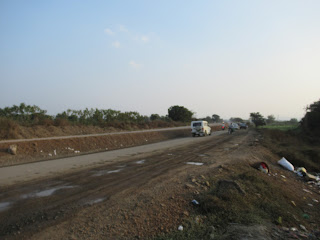Four hours from Aurangabad on an extremely rocky, half finished highway we reached the Ajanta cave complex.
 |
| To the caves... |
 |
| ...from the caves |
Next day we visited the much closer yet even more impressive and mystifying Ellora caves.
Some say Kailasha Temple (#16) was the work of aliens and, for once, it is easier to just believe than question:
Estimates put its completion at 18 years. The whole thing was chiselled - TOP DOWN - from the bare rock - IN ONE PIECE - which meant workers (slaves) working round the clock would have shifted 2.5 tons of rock - PER DAY - for all 18 years.
Look on our works ye mighty, and despair!
We rounded the day off with a 750-step yomp to the top.of Daulatabad Fort for fabulous views of the surrounding area.
Enough said. The boring history stuff is below. Here are the photos, in no particular order:
WIKI BLURB:
The AJANTA CAVES are 30 (approximately) rock-cut Buddhist cave monuments which date from the 2nd century BCE to about 480 CE in Aurangabad district of Maharashtra state of India.[1][note 1] The caves include paintings and rock-cut sculptures described as among the finest surviving examples of ancient Indian art, particularly expressive paintings that present emotions through gesture, pose and form.
UNESCO:
ELLORA (\e-ˈlȯr-ə\, IAST: Vērūḷ) (एलोरा) is a UNESCO World Heritage Site located in the Aurangabad district of Maharashtra, India. It is one of the largest rock-cut monastery-temple cave complexes in the world, featuring Hindu, Buddhist and Jain monuments, and artwork, dating from the 600–1000 CE period.[1][2] Cave 16, in particular, features the largest single monolithic rock excavation in the world, the Kailasha temple, a chariot shaped monument dedicated to Lord Shiva. The Kailasha temple excavation also features sculptures depicting the gods, goddesses and mythologies found in Vaishnavism, Shaktism as well as relief panels summarizing the two major Hindu Epics.
WIKI BLURB:
DAULATABAD FORT also known as Devagiri or Deogiri, is a historical fortified citadel located in Aurangabad, Maharashtra, India. It was the capital of the Yadava dynasty (9th century–14th century CE), for a brief time the capital of the Delhi Sultanate (1327–1334), and later a secondary capital of the Ahmadnagar Sultanate (1499–1636). Fort, the new city of Aurangabad, then named Khadki, was established to serve as the capital of the Ahmadnagar Sultanate by the Ethiopian military leader Malik Ambar, who was brought to India as a slave but rose to become a popular Prime Minister of the Ahmadnagar Sultanate. Most of the present-day fortification at Daulatabad Fort was constructed under the Ahmadnagar Sultanate.





































No comments:
Post a Comment